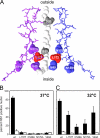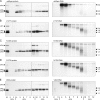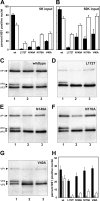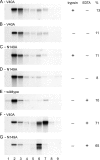Mutations at the base of the icosahedral five-fold cylinders of minute virus of mice induce 3'-to-5' genome uncoating and critically impair entry functions
- PMID: 22013064
- PMCID: PMC3255873
- DOI: 10.1128/JVI.06119-11
Mutations at the base of the icosahedral five-fold cylinders of minute virus of mice induce 3'-to-5' genome uncoating and critically impair entry functions
Abstract
The linear single-stranded DNA genome of minute virus of mice can be ejected, in a 3'-to-5' direction, via a cation-linked uncoating reaction that leaves the 5' end of the DNA firmly complexed with its otherwise intact protein capsid. Here we compare the phenotypes of four mutants, L172T, V40A, N149A, and N170A, which perturb the base of cylinders surrounding the icosahedral 5-fold axes of the virus, and show that these structures are strongly implicated in 3'-to-5' release. Although noninfectious at 37°C, all mutants were viable at 32°C, showed a temperature-sensitive cell entry defect, and, after proteolysis of externalized VP2 N termini, were unable to protect the VP1 domain, which is essential for bilayer penetration. Mutant virus yields from multiple-round infections were low and were characterized by the accumulation of virions containing subgenomic DNAs of specific sizes. In V40A, these derived exclusively from the 5' end of the genome, indicative of 3'-to-5' uncoating, while L172T, the most impaired mutant, had long subgenomic DNAs originating from both termini, suggesting additional packaging portal defects. Compared to the wild type, genome release in vitro following cation depletion was enhanced for all mutants, while only L172T released DNA, in both directions, without cation depletion following proteolysis at 37°C. Analysis of progeny from single-round infections showed that uncoating did not occur during virion assembly, release, or extraction. However, unlike the wild type, the V40A mutant extensively uncoated during cell entry, indicating that the V40-L172 interaction restrains an uncoating trigger mechanism within the endosomal compartment.
Figures








Similar articles
-
VP2 cleavage and the leucine ring at the base of the fivefold cylinder control pH-dependent externalization of both the VP1 N terminus and the genome of minute virus of mice.J Virol. 2006 Jan;80(1):161-71. doi: 10.1128/JVI.80.1.161-171.2006. J Virol. 2006. PMID: 16352540 Free PMC article.
-
Depletion of virion-associated divalent cations induces parvovirus minute virus of mice to eject its genome in a 3'-to-5' direction from an otherwise intact viral particle.J Virol. 2010 Feb;84(4):1945-56. doi: 10.1128/JVI.01563-09. Epub 2009 Dec 2. J Virol. 2010. PMID: 19955311 Free PMC article.
-
Low pH-dependent endosomal processing of the incoming parvovirus minute virus of mice virion leads to externalization of the VP1 N-terminal sequence (N-VP1), N-VP2 cleavage, and uncoating of the full-length genome.J Virol. 2006 Jan;80(2):1015-24. doi: 10.1128/JVI.80.2.1015-1024.2006. J Virol. 2006. PMID: 16379002 Free PMC article.
-
Parvoviral host range and cell entry mechanisms.Adv Virus Res. 2007;70:183-232. doi: 10.1016/S0065-3527(07)70005-2. Adv Virus Res. 2007. PMID: 17765706 Review.
-
Coping with parvovirus infections in mice: health surveillance and control.Lab Anim. 2012 Jan;46(1):14-23. doi: 10.1258/la.2011.011025. Epub 2011 Oct 28. Lab Anim. 2012. PMID: 22037057 Review.
Cited by
-
Toll-like receptor 9 in plasmacytoid dendritic cells fails to detect parvoviruses.J Virol. 2013 Mar;87(6):3605-8. doi: 10.1128/JVI.03155-12. Epub 2013 Jan 9. J Virol. 2013. PMID: 23302877 Free PMC article.
-
Concepts to Reveal Parvovirus-Nucleus Interactions.Viruses. 2021 Jul 5;13(7):1306. doi: 10.3390/v13071306. Viruses. 2021. PMID: 34372512 Free PMC article. Review.
-
Structural basis for biologically relevant mechanical stiffening of a virus capsid by cavity-creating or spacefilling mutations.Sci Rep. 2017 Jun 22;7(1):4101. doi: 10.1038/s41598-017-04345-w. Sci Rep. 2017. PMID: 28642465 Free PMC article.
-
Maintenance of the flip sequence orientation of the ears in the parvoviral left-end hairpin is a nonessential consequence of the critical asymmetry in the hairpin stem.J Virol. 2012 Nov;86(22):12187-97. doi: 10.1128/JVI.01450-12. Epub 2012 Aug 29. J Virol. 2012. PMID: 22933276 Free PMC article.
-
Parvovirus B19 Uncoating Occurs in the Cytoplasm without Capsid Disassembly and It Is Facilitated by Depletion of Capsid-Associated Divalent Cations.Viruses. 2019 May 10;11(5):430. doi: 10.3390/v11050430. Viruses. 2019. PMID: 31083301 Free PMC article.
References
-
- Agbandje-McKenna M, Llamas-Saiz AL, Wang F, Tattersall P, Rossmann MG. 1998. Functional implications of the structure of the murine parvovirus, minute virus of mice. Structure 6:1369–1381 - PubMed
Publication types
MeSH terms
Substances
Grants and funding
LinkOut - more resources
Full Text Sources
Other Literature Sources

